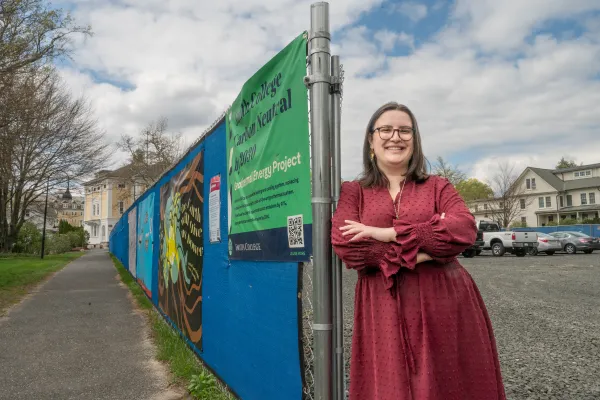Corinna Davis ’23: Smith’s First Geothermal Tour Guide
Sustainability

Corinna Davis ’23 standing by wells being dug for Smith's geothermal project. Photo by Shana Sureck.
Published April 27, 2023
Corinna Davis ’23 holds up a diagram she created of a heat pump to help explain the complex workings of a renewable energy project taking shape on campus.
The half-dozen Smith and Northampton community members who have followed her to Davis lawn on this late afternoon draw closer so they can hear the details.
As the first student guide for Smith’s $210 million geothermal energy project, Davis has led dozens of people on similar tours over the past two semesters. She has also given talks about geothermal energy in her role as an intern for the Center for the Environment, Ecological Design and Sustainability.
Launched in May 2022, the geothermal project is designed to lower Smith’s carbon emissions by 90 percent, allowing the college to meet its goal of becoming carbon neutral by 2030. The project, which will take seven years to complete, involves replacing Smith’s aging fossil fuel–fired heating system with an electrically-powered geothermal system that harnesses the stable temperature of the ground.
Davis, who is majoring in engineering, first heard about the student tour guide position from Associate Professor of Engineering Denise McKahn. In 2019, McKahn led a pilot project that created a geothermal heating and cooling system for Smith’s Field House—research that helped propel the campuswide project now under construction.
The college’s new geothermal system will use electrically-powered heat pumps to transfer energy from the ground via piped water—first to an energy plant and then to individual buildings for heating and cooling. In the current phase of the project, wells are being dug on Davis lawn and pipes are being laid to the Capen Boiler building, which will serve as an energy distribution hub for that section of campus.
Beth Hooker, Smith’s director of sustainability, says Davis brought both her engineering background and her “keen interest in communicating complex ideas to diverse audiences to her work” as a geothermal tour guide.
“Not only did she design the tours—making modifications as she went along,” notes Hooker, “but she also designed and delivered a series of renewable energy lunch learn-ins, covering the opportunities and challenges presented by wind, solar, hydroelectric, and biofuels.”
Here’s what Davis had to say about her experience.
How did you become a tour guide for the geothermal project?
“I’m an engineering major, and renewable energy is my cup of tea. Last spring, [Sustainability Director] Beth Hooker was looking for students to staff information tables about the geothermal project while the board of trustees was here. I got to see students interacting and talking about something they were excited about. People were really proud of Smith that day! After that, Beth mentioned an interest in having students do tours of the project. What I want to do is science communication—making technical issues accessible to everyone. So that was the perfect job for me. I got to pilot the student tours.”
How did you prepare for your first tours, with so much new information to absorb?
“Denise McKahn and other professors had run tours before, so I had some guidance on that. In terms of the construction starting in the fall, I would walk the tour route every day to be sure it hadn’t been blocked. I also got weekly construction updates via email. And I took a geothermal course, so I could bring a knowledge of design. We’ve just started getting more Northampton community people on the tours. And I’ve been taking calls from students from other colleges who want to know about what we’re doing with geothermal. We really are a role model.”
What kinds of questions do people ask you during the tours?
“I get a lot of the same questions. Sometimes people stump me and I have to say, ‘do you want my email and I’ll get back to you on that?’ I really like getting questions where people are poking to see how environmentally friendly this project is. Someone asked me if this would cause earthquakes, like fracking. (The answer is no. The geothermal wells don’t go nearly that deep.) It’s very clear that people want to make sure we are not making mistakes with this technology.”
What have you learned from leading the tours?
“One real challenge for me was explaining how a heat pump works. If you lay out the base level of physics, you can get to a place of understanding about that. I’ve learned how to answer questions and not be nervous about talking about how this system is really complicated and there can be downsides. We’ll need more solar projects because of the increase geothermal makes in our electrical load. It’s important for people to realize that the design of these projects can change as they go along. The design iteration process is super intense, but that’s also what makes it fun.”
How does this experience fit into your plans for life after Smith?
“I hope to be a designer on a project like this some day, maybe on geothermal projects for big office buildings in New York City. This market is hiring fast. It gives me a lot of hope to see the amount of people in this field. When you’re working on renewable energy, your anxiety about the environment diminishes.”
What advice do you have for the next student tour guide when the program continues in the fall?
“They should take it and make it their own—do what they’re excited to do. What’s important is having a new person who’s interested in sustainable energy talking to people about this project.”